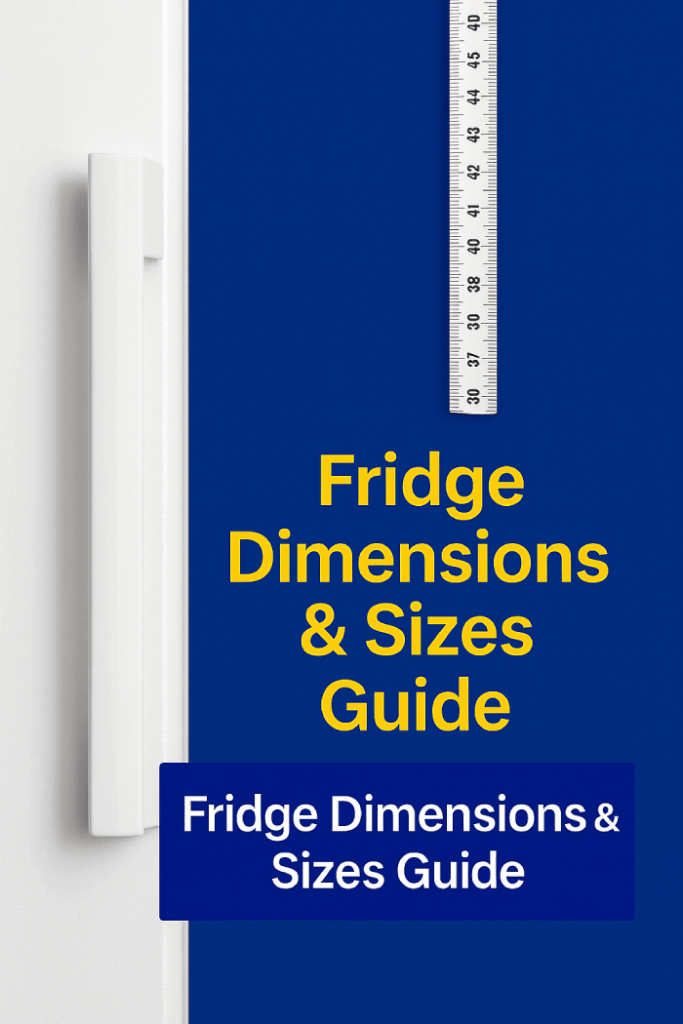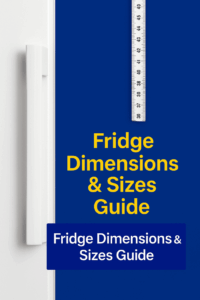Buying a refrigerator is not only about appearance or brand. You should have the correct fridge and one that fits the correct size. It will impact functionality, efficiency, as well as flawless kitchen integration. To ensure that you are picking the right fridge, this article will simplify it all for you to learn about standard refrigerator sizes so that you can make the best decision for your home.
Standard Refrigerator Dimensions at a Glance
Most standard fridges are within these ranges:
- Width: 28-36 inches (71-91cm)
- Height: 66-72 inches (168-183cm)
- Depth: 26-34 inches (66-86cm)
But dimensions can change based on your fridge style, capacity needs, and kitchen space considerations.
Related: Dishwasher Brands to Avoid: A Practical Guide
Refrigerator Styles and Their Typical Measurements
| Style | Width (in, cm) | Height (in, cm) | Depth (in, cm) | Capacity Range | Best For |
| Top Freezer | 28-33 in (71-84cm) | 61-66 in (155-168cm) | 28-34 in (71-86cm) | 14-22 cu ft (396-623 litres) | Smaller kitchens,budget-conscious households, and secondary refrigeration. |
| Bottom Freezer | 29-36 in (74-91cm) | 67-70 in (170-178cm) | 33-36 in (84-91cm) | 18-25 cu ft (510-708l) | Families who prioritise fresh food accessibility. |
| Side-by-Side | 32-36.5 in (81-93cm) | 66-70 in (168-178cm) | 28-29.5 in (71-75cm) | 20-28 cu ft (566- 793l) | Kitchens with limited door swing space and households needing equal freezer/refrigerator access. |
| French Door | 33-36 in (84-91cm) | 68-70 in (173-178cm) | 28.25-29.5 in (72-75cm) | 22-31 cu ft (623- 878l) | Larger families, entertainers, and gourmet cooks need wide shelf space. |
| Counter-Depth | 30-36 in (76-91cm) | 66-72 in (168-183cm) | 23-27 in (58-69cm) | 16-23 cu ft (453- 651l) | Design-conscious homeowners seek a seamless kitchen appearance. |
Speciality and Compact Refrigerator Sizes
| Type | Width (in, cm) | Height (in, cm) | Depth (in, cm) | Capacity Range | Best For |
| Apartment-Sized | 18-24 in (46-61cm) | 60-75 in (152-190cm) | 28-30 in (71-76cm) | 10-18 cu ft (283-510 litres) | Small apartments, efficiency units, space-conscious households |
| Mini Fridges | 14-24 in (36-61cm) | 16-18 in (41-46cm) | 20-22 in (51-56cm) | 1.7-4.5 cu ft (48-127l) | Dorm rooms, offices, guest rooms, and entertainment areas |
| Wine Refrigerators | 14-24 in (36-61cm) | 16-36 in (41-91cm) | 20-30 in (51-76cm) | 12-50 bottles (capacity varies) | Wine enthusiasts, entertainers, and dedicated beverage storage. |
Capacity Guidelines: How Much Space Do You Need?
The ideal freezer temperature and overall refrigeration capacity depend on your household size and food storage habits:
- Singles/Couples: 14-20 cubic feet (396- 566 L)
- Family of Four: 20-25 cubic feet (566- 708l L)
- Large Families/Entertainers: 25+ cubic feet (708+ L)
A Rule: Allow 4-6 cubic feet of refrigerator space per person in your household.
Essential Measurement Tips for Perfect Refrigerator Fit
Before Shopping
1. Width Measurements
-
- Measure at three points: floor level, countertop height, and upper cabinet.
- Use the smallest measurement as your guide.
- Add 1 inch on each side for proper ventilation.
2. Height Considerations
- Measure from the floor to the bottom of any overhanging cabinets.
- Allow a minimum 1-inch clearance above the refrigerator.
- Remember the space for hinge clearance.
3. Depth Dimensions
- Measure from the back wall to the counter edge
- For standard-depth models, make sure there is enough space for the door swing
- Consider the traffic flow when the doors are open
4. Delivery Path Assessment
- Measure all doorways, hallways, and stairwells.
- Check for tight corners or obstacles.
- Confirm elevator dimensions if applicable.
Tip: Allow at least 2 inches behind the fridge for proper airflow. This is important for optimal freezer temperature maintenance and compressor efficiency in 2025 models, according to Samsung’s installation guidelines.
Related: What Temperature Should a Fridge Be? Fridge Temperature Guide
Counter-Depth vs. Standard-Depth: Which Is Right for You?
Standard-Depth Refrigerators
- Extend 5-7 inches beyond the counter edge.
- Offer maximum storage capacity.
- More economical price point
- Ideal when storage needs exceed aesthetic concerns.
Counter-Depth Refrigerators
- Align flush with countertops (typically 24-27 inches deep).
- Create a streamlined, built-in appearance.
- Slightly smaller capacity but improved kitchen flow.
- Premium price because of the aesthetic.
Built-In Refrigerators: The Premium Option
They offer the ultimate custom look requires special considerations:
- Width: 30-48 inches (typically in 6-inch increments)
- Height: Often taller, up to 84 inches
- Depth: Designed to align perfectly with 24-inch cabinets
- Panel-Ready Options: Can accept custom panels to match cabinetry.
The ideal freezer temperature settings and energy efficiency features in 2025’s built-in models rival freestanding units, making them practical luxury investments.
Common Refrigerator Installation Mistakes to Avoid
- Ignoring Ventilation Requirements: Modern fridges need proper airflow to maintain ideal freezer temperatures and efficiency.
- Forgetting About Door Swing Clearance: Especially critical with French door and side-by-side models.
- Overlooking Electrical Outlet Placement: Make sure an adequate, dedicated power supply that meets 2025 safety codes.
- Neglecting Water Line Requirements: For models with ice markers or water dispensers, proper water line installation is important.
- Choosing size based solely on available space: Think about your actual storage needs and daily usage patterns.
Energy Efficiency and Organisation Tips
- Right-size Your Refrigerator: Models that are too large waste energy maintaining an ideal temperature in unused space.
- Use Organisation System: Bins and containers improve airflow and accessibility.
- Consider ENERGY STAR Models: According to ENERGY STAR’s 2025 refrigerator guidelines, certified models use up to 15% less energy than non-certified units.
- Adjust shelving to fit your needs: Customizable interiors maximise usable space.
According to the U.S. Department of Energy, refrigerators take up 7% of a household’s total energy consumption. So, choosing the right size and maintaining the ideal freezer temperature of 0°f (-18 °c) can affect your home’s energy footprint.
Conclusion
The right fridge will bring both function and style to your kitchen. All you need to know is the standard refrigerator dimensions and how they fit your specific space and needs; you will be able to make an informed decision.
Remember that maintaining the ideal freezer temperature of 0°f (-18C) is easier and better. Take your time with measurements, consider your household’s unique needs, and think about how different styles will function in your daily routine.
For more such information, get in touch with Barton Appliance Repair.





